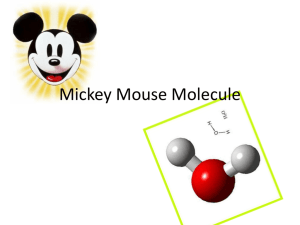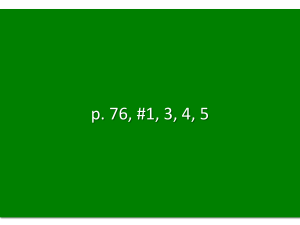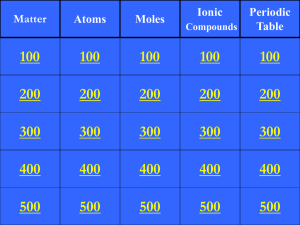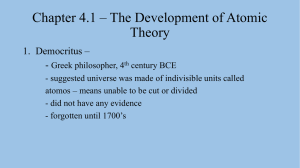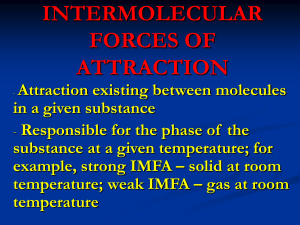Lecture 20
advertisement
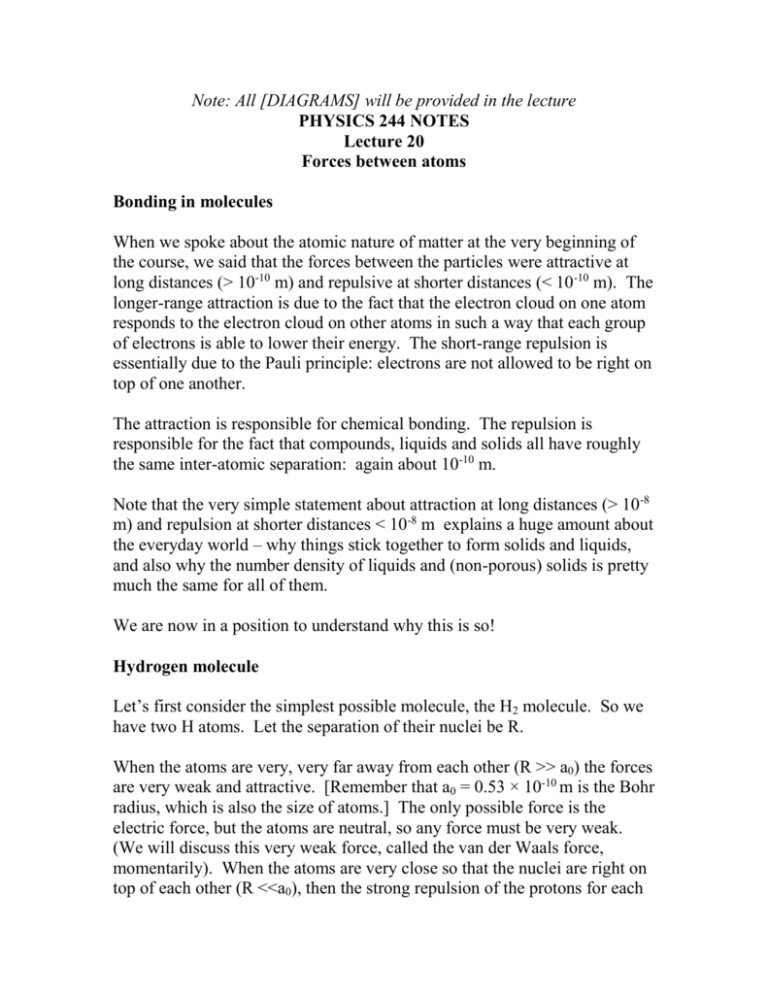
Note: All [DIAGRAMS] will be provided in the lecture PHYSICS 244 NOTES Lecture 20 Forces between atoms Bonding in molecules When we spoke about the atomic nature of matter at the very beginning of the course, we said that the forces between the particles were attractive at long distances (> 10-10 m) and repulsive at shorter distances (< 10-10 m). The longer-range attraction is due to the fact that the electron cloud on one atom responds to the electron cloud on other atoms in such a way that each group of electrons is able to lower their energy. The short-range repulsion is essentially due to the Pauli principle: electrons are not allowed to be right on top of one another. The attraction is responsible for chemical bonding. The repulsion is responsible for the fact that compounds, liquids and solids all have roughly the same inter-atomic separation: again about 10-10 m. Note that the very simple statement about attraction at long distances (> 10 -8 m) and repulsion at shorter distances < 10-8 m explains a huge amount about the everyday world – why things stick together to form solids and liquids, and also why the number density of liquids and (non-porous) solids is pretty much the same for all of them. We are now in a position to understand why this is so! Hydrogen molecule Let’s first consider the simplest possible molecule, the H2 molecule. So we have two H atoms. Let the separation of their nuclei be R. When the atoms are very, very far away from each other (R >> a0) the forces are very weak and attractive. [Remember that a0 = 0.53 × 10-10 m is the Bohr radius, which is also the size of atoms.] The only possible force is the electric force, but the atoms are neutral, so any force must be very weak. (We will discuss this very weak force, called the van der Waals force, momentarily). When the atoms are very close so that the nuclei are right on top of each other (R <<a0), then the strong repulsion of the protons for each other, and the strong repulsion of the electrons for each other, will guarantee that the force is repulsive. Furthermore, the exclusion principle (if the electron spins are parallel) says that two electrons cannot share the same wavefunction and this will also forbid the atoms from being in the same spot. When the atoms have the intermediate separation, so that R is roughly equal to a0, things are more interesting. This is where we can get covalent bonding. In this case, the electrons are shared: H2 molecule: 2 electrons, 2 protons. First consider the potential curve for a single electron at position x in the vicinity of two fixed protons at r1 and r2: V(x) = -ke2/|x-r1| - ke2/|x-r2| [[DIAGRAM]] We can very roughly think of the atomis potential as two finite square wells that coalesce as the atoms come together. So the kinetic energy of the two electrons is KE = ħ2 π2 / 2 m L2 + ħ2 π2 / 2 m L2 = ħ2 π2 / m L2 if the two atoms are far apart and each contains one electron, but E = 2 × ħ2 π2 / 2 m (2L)2 = ħ2 π2 / 4m L2 if the two atoms are close and the electrons are in the middle. This implies that the ground state has two electrons that want to stay largely in between the atoms, but with their spins antiparallel. This means that the potential energy curve E(R) for the two nuclei has a minimum – the equilibrium separation is 0.74 × 10-8 m and the binding energy is 4.25 eV. This is called covalent bonding, and it depends on the availability of empty states in the outer shell of the atom. In the H atom, the electrons use the 1s state on the two atoms. This has four slots, but only the two lower ones have a low energy. So the ground state has two electrons with opposite spins. This kind of rule, counting slots for the electrons, is what gives most chemical bonding rules. Organic compounds One important example is methane CH4. C has 4 slots and H has 1 in their respective outer shells. So CH4, not CH2 or CH5, is a stable compound. Its geometry is such that the C sits at the center of a tetrahedron and the H’s sit at the vertices. Increasing the number of electrons on C by 1 gives us N, and so we expect a stable compound NH3, which is indeed ammonia. Going one step further gives us H2O, also known as water. Gasoline is made from carbon chains bonded to form compounds with formula CnH2n+2. These are called alkanes. van der Waals forces This is the sort of weak bonding that occurs between neutral atoms that are too far away from each other to have covalent bonds. It is the one responsible for the weak attraction we mentioned before that acts at very large distances. The electron cloud of one atom slightly polarizes the electron cloud of another, with a result that is always attractive. The attraction is proportional to r-6 except at very long distances where it becomes r-7. For atoms with filled shells, this is the only type of attractive force, so it dominates the binding of such systems as solid Ne. The main importance of these kinds of forces are when we go to a higher level and think about forces between covalently bonded molecules, rather than forces between atoms. The formation of the molecules has used up all the slots for electrons to share, so the van der Waals forces are the only ones left. These kinds of forces are extremely important in biochemistry, though they usually go by the name of polarization forces or of hydrophilic and hydrophobic forces. The position of molecules or parts of molecules in biological structures is determined by whether they are hydrophilic (highly polarizable) and therefore very strongly attracted to highly polarizable water, or hydrophilic (not very polarizable), and therefore not so strongly attracted to water. Hydrophilic parts will tend to stick to hydrophobic parts and will also attract water. The hydrophobic parts will end up together as well, since they are attracted, albeit weakly, to each other, and they will be displaced by the hydrophilic parts.
